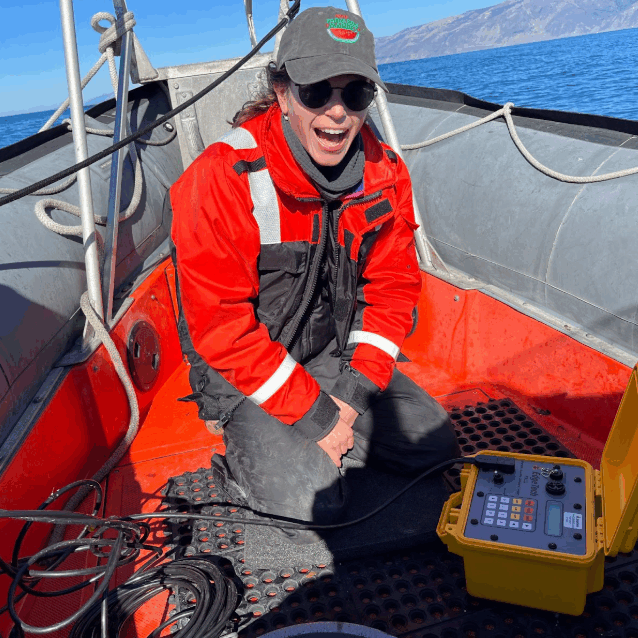
Dr. Vanessa ZoBell and understanding human uses in the ocean and the impact on sound
Dr. ZoBell measures and models sound in the ocean, quantifying and characterizing human-made noises, and identifying ways to reduce noise pollution. She’s committed to the application of sustainable ocean solutions to support the blue economy through multidisciplinary research.
Share
For seven years, Protecting Blue Whales and Blues Skies (BWBS) has been worked with Dr. Vanessa ZoBell, a researcher at Scripps Institution of Oceanography specializing in acoustical oceanography and human use of the modern ocean.
Dr. ZoBell measures and models sound in the ocean, quantifying and characterizing anthropogenic (human-made) noises, and identifying ways to reduce noise pollution. She’s committed to the application of sustainable ocean solutions, and regularly collaborates with NGOs, industry, and agencies to inform policy at all levels to support the blue economy through multidisciplinary research.
“I love engaging with different stakeholders and learning how the ocean and shipping have influenced, shaped, and become integral to their lives. I see a strong interest and commitment across ocean dependent sectors to identify solutions to reduce noise impacts – this is what motivates me and my work. I am hopeful that we will discover solutions, and the data will guide us there.” – Dr. Vanessa Zobell
Recent Work: How the Sound of the Planet Reflects the Health of the Planet
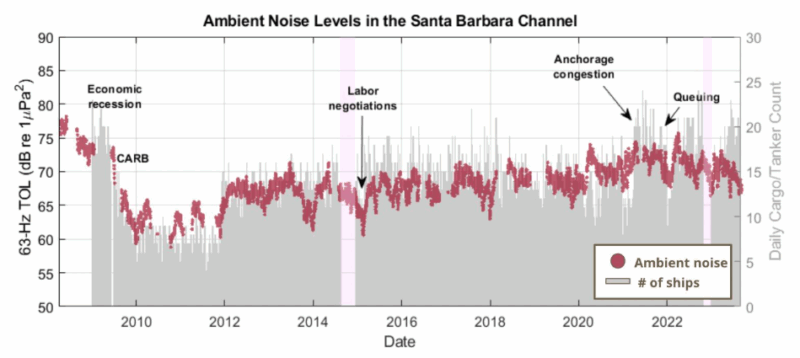
Ambient noise levels in the Santa Barbara Channel’s Vessel Speed Reduction Zone are closely tied to daily vessel traffic and fluctuate in response to economic events such as recessions and labor negotiations.
Apart from leading BWBS’ analysis on the noise pollution reduction benefits of slowing ships, Vanessa was lead author on a new study published in the Journal of Acoustical Society of America’s (JASA) special issue: Climate Change: How the Sound of the Planet Reflects the Health of the Planet. Her study – Climatic and economic fluctuations revealed by decadal ocean soundscapes– analyzed over 15 years of continuous passive acoustic recordings from six sites in the Southern California Bight (within BWBS Vessel Speed Reduction Zones), to examine long-term patterns in ambient noise levels.
By assessing vessel traffic noise and baleen whale vocalizations, the team identified clear connections between low-frequency noise (the frequencies that whales use, and that the vessels radiate) and large-scale climatic shifts, such as the Pacific Decadal Oscillation, as well as economic events like port slowdowns and labor disruptions. Their paper includes findings on BWBS’ impact as a driver of vessel behavior in the region, and as a method to continue the reduction of underwater noise pollution.
California is the world’s fourth-largest economy, and the paper highlights how economic activity is a primary driver of the low-frequency ocean soundscape. While vessel noise can degrade otherwise pristine environments, its anthropogenic origin also presents an opportunity: unlike many natural sources, it is controllable. Programs such as BWBS demonstrate how targeted noise-reduction strategies such as reducing vessel speed can be implemented in regions where they are most urgently needed.
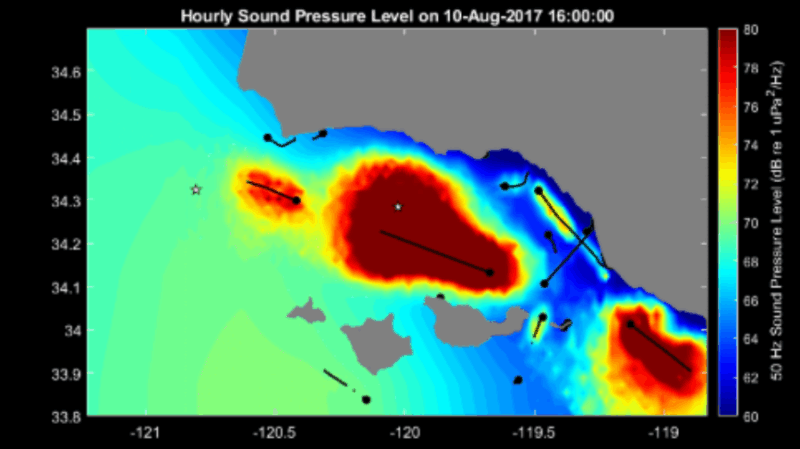
Ship noise (colors) propagates far beyond a vessel’s track lines (black lines). The effects of noise can radiate into protected and biologically important areas, even if a vessel is outside of the boundaries.
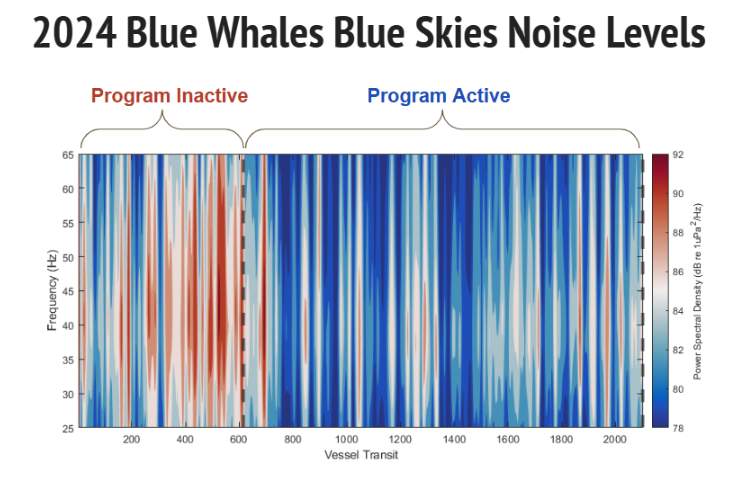
While the Protecting Blue Whales and Blue Skies program is active, vessel transits are noticeably quieter than when the program is inactive due to their slower speeds.
What else is Vanessa up to?
Vanessa has worked with a range of stakeholders in the maritime industry, helping different sectors better understand ocean noise. She collaborated with Maersk-Line to quantify the noise reduction achieved through their retrofitting initiative and continues to work with shipping lines to incorporate underwater radiated noise considerations into retrofitting projects and new vessel designs. She has also engaged with international ports at Green Tech 2025, hosted by Green Marine, a sustainable shipping certification program. While much of her work is based in California, she is also involved in projects in the Gulf of Mexico, investigating how human-made noise impacts other modern ocean basins and the animals that inhabit them.
Example recordings and places to listen to the ocean soundscape:
Publications, Research Articles & Media:
- Climatic and economic fluctuations revealed by decadal ocean soundscapes
- Underwater noise mitigation in the Santa Barbara Channel through incentive-based vessel speed reduction
- Assessing approaches for ship noise reduction within critical whale habitat
- Comparing pre-industrial and modern ocean noise levels in the Santa Barbara Channel
- Retrofit-induced changes in the radiated noise and monopole source levels of container ships
- Podcast Episode: Reducing Shipping Noise for Fatter, Happier Marine Mammals
- Youtube Episode: Saving Whales in Noisy Oceans
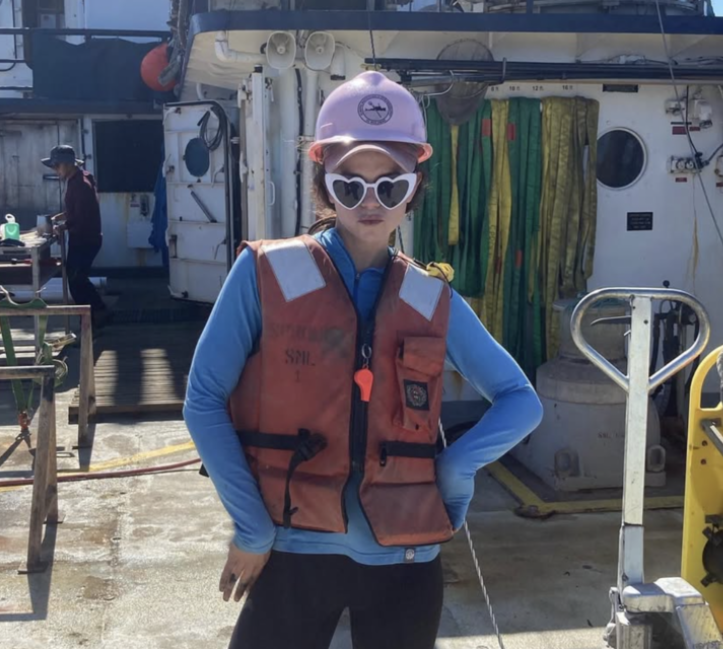
Posing after a successful acoustic instrument recovery in Southern California.